_We may earn revenue from the products available on this page and participate in affiliate programs. Learn more ›
_
Best Traditional
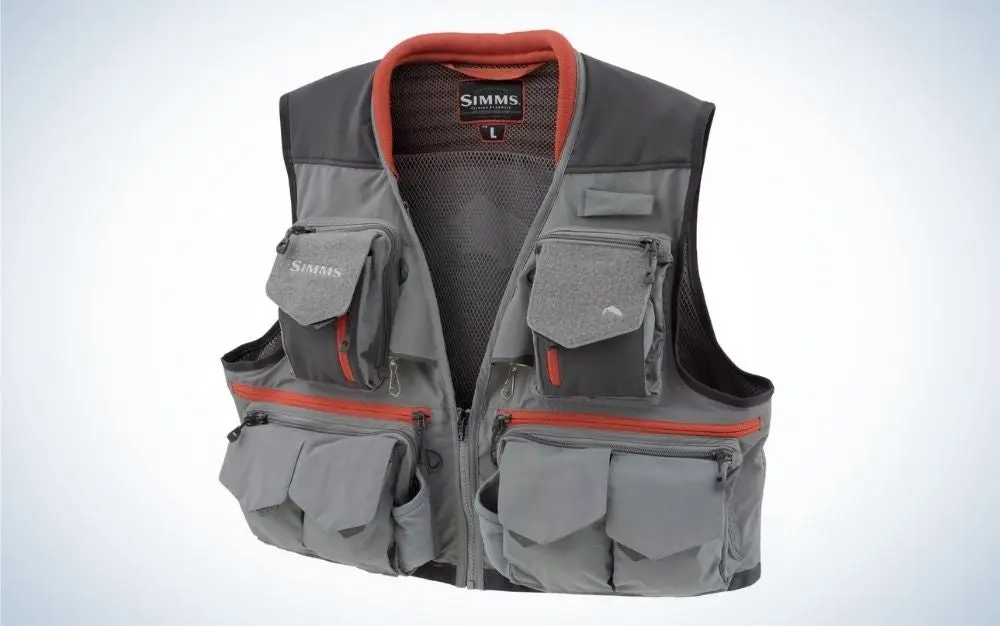
Simms Guide Vest
Best For Trout
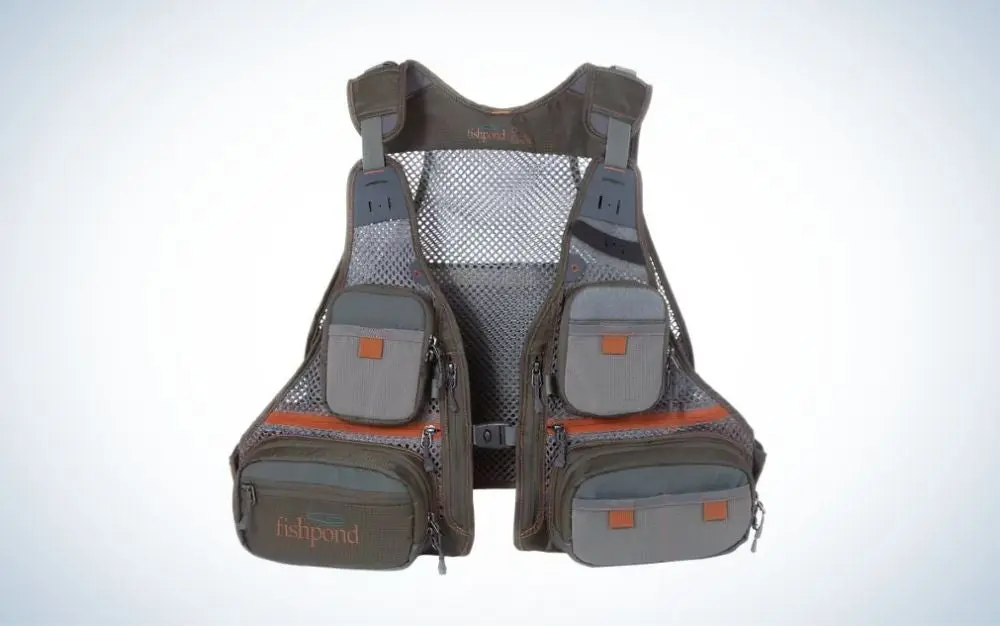
Fishpond Sagebrush Pro Mesh Vest
Best for Beginners
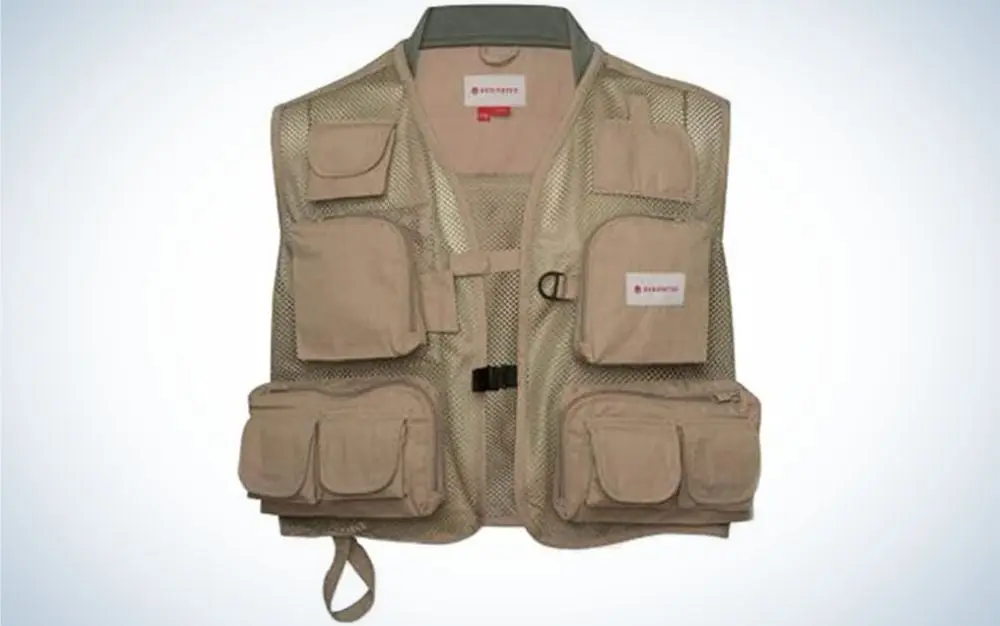
Redington Blackfoot Vest
Fly fishing vests have been around since the beginning of the sport, and they’re still great for both beginners and experienced anglers. Designed to keep your flies and gear organized for when you need them, a fly fishing vest should have plenty of pockets for organization, be lightweight and breathable, and be comfortable enough to wear all day.
While fishing backpacks
and sling packs
have grown in popularity, the vest is still the best way to keep everything organized and at hand. Whether you need a quick fly change or an entire rerigging, the best fly fishing vests can get you back to fishing in no time.
Best Traditional: Simms Guide Vest
Best for Trout: Fishpond Sagebrush Pro Mesh Vest
Best Lightweight: Orvis Ultralight Vest
Best for Beginners: Redington Blackfoot Vest
Most Versatile: Fishpond Ridgeline Tech Pack
How We Picked The Best Fly Fishing Vests
As an avid fly angler and fisheries biologist, it’s been my life’s goal to fish as many places for as many species as possible. Along the way, I have used nearly every version of vest, sling pack, and backpack imaginable to haul my fishing gear around—and if I had to choose only one, it’d be a vest. The combination of comfort and organization is far superior to other choices. A good vest is comfortable to wear, built to withstand the elements, and above all, keeps your gear organized and at hand. Whether you are new to fly fishing or want a simple and reliable way to keep your gear organized, a vest is the way to go. I based my selections on the following criteria.
Materials: What fabric is used and how durable is it?
Weight: How much does the vest weigh and how does it affect performance?
Storage: How much storage space is there for fly boxes and accessories?
Layout: Are the pockets positioned for optimal access?
Comfort: Is the vest comfortable to wear all day and on long trips?
Breathability: What features does the vest have for airflow?
The Best Fly Fishing Vets: Reviews & Recommendations
**Best Traditional: Simms Guide Vest
**
Best Traditional Fly Fishing Vest

Specs
Weight: 20 oz.
Material: Cordura nylon ripstop with polyester lining
Sizing: S-2XL
Pros
Plenty of storage
Tough fabric
Water-resistant finish
Very comfortable design and materials
Cons
Expensive
Simms has long been known for building quality products that last season after season, and the Guide Vest is no exception. It is constructed of Cordura ripstop nylon which is soft and incredibly durable. I’ve trudged through thickets that looked impassible in order to get to the water, and the vest seems unphased. In addition to its durability, the vest is plenty breathable with a mesh lining designed to shed body heat and minimize sweating. From an organizational standpoint, Simms thought of everything imaginable, with plenty of external pockets for fly boxes, tippet spools, leaders, and more. For my valuables like a phone or wallet, I prefer the inside pockets to keep them further from the water. It has handy built-in tool retractors for nippers or other small tools placed above the zipper for easy access. It’s not cheap, but for those looking for ample storage in a water-resistant and comfortable package, this is the vest you want.
Best for Trout: Fishpond Sagebrush Pro Mesh Vest
Best for Trout

Specs
Weight: 25 oz.
Material: 210D Nylon
Sizing: One size
Pros
Minimalist design
Very breathable
Net holster for easy access
Cons
One size fits all
The Fishpond Sagebrush Pro Mesh Vest is a modern take on a classic design built with trout anglers in mind. When I first tried one on, I immediately noticed how open it is due to its minimalist design. Unlike other vests, I can easily wear several layers and still feel unrestricted by the vest. However, the vest does not sacrifice storage—it has large front pockets for fly boxes and plenty of smaller pockets for accessories. It’s built with a 210-denier nylon fabric that is one of the more abrasion-resistant materials I’ve seen. The best part about this vest is its compatibility with other Fishpond products, such as nets. My biggest issue with vests had always been the net flopping around on a quick-release clip, especially when it snags going through thick brush. The back panel has a net holster designed to keep the net secure while you’re walking.
Best Lightweight: Orvis Ultralight Vest
Best Lightweight
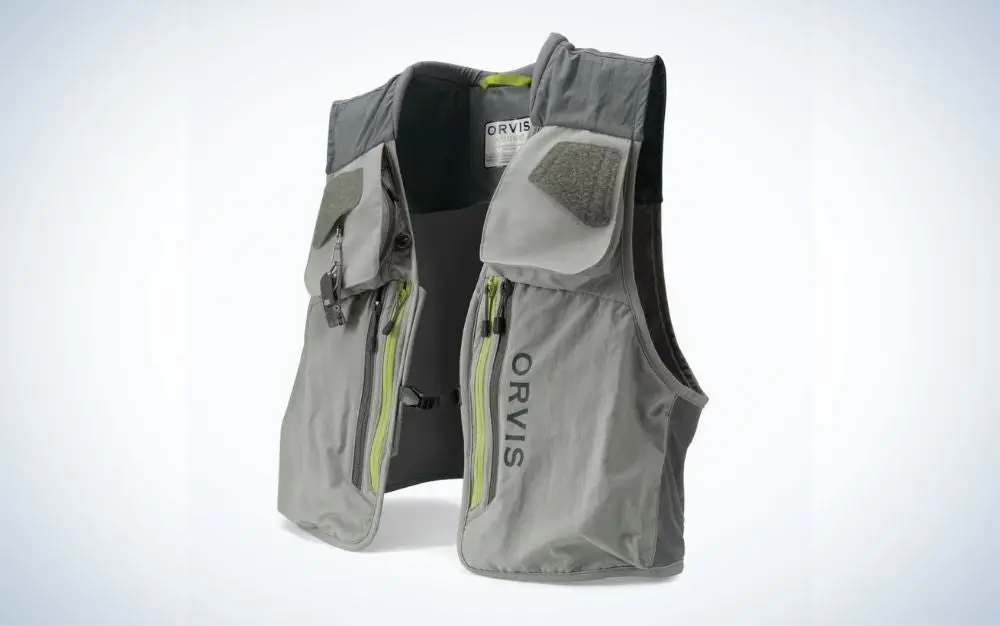
Specs
Weight: 12 oz.
Material: Woven nylon with a DWR coating
Sizing: S-XXL
Pros
Very breathable and water-resistant
Lightweight
Well laid out storage
Cons
The internal zipper pocket is too small for phones
Orvis built this vest with the sole purpose of making it as lightweight as possible, but also created a well-laid-out and durable vest. Weighing in at 12 ounces, it is by far the lightest vest we tested, so you don’t have to leave extra fly boxes behind to save a few pounds. It features side-opening pockets. This design improves access to fly boxes and other items by moving the pocket openings directly in front of your line of sight. My favorite features are the tool retractors and loops for a tippet bar across your chest. On previous vests, I used a lanyard to achieve the same result, but this vest allows you to keep all your tools and tippets accessible to quickly retie. If you’re looking for a good vest to pack on a trip or just want something lightweight, the Ultralight Vest is a great option.
Best for Beginners: Redington Blackfoot Vest
Best for Beginners

Specs
Weight: 12 oz.
Material: Cloth blend
Sizing: Small- 3XL
Pros
Budget-friendly
Plenty of storage
Range of sizes
Cons
Loose-fitting without a center zipper
For beginners learning to fly fish, there is a lot of information to take in, so it helps to simplify as many things as possible. The Redington Blackfoot Vest is a great choice for reliable organization on the water, and it comes at a budget-friendly price. This was my first fly fishing vest. I was able to keep all my flies, tippets, and accessories organized and accessible. Knowing where things are can help you rerig faster and fish for longer, which is crucial for those just starting out. The built-in rod holder comes in handy because it leaves your hands free to tie on new flies or modify rigs. For a vest, at this price point, it is surprisingly lightweight and comfortable, and the back pouch lets you store larger gear such as a rain jacket or snacks for all-day adventures.
**Most Versatile: Fishpond Ridgeline Tech Pack
**
Most Versatile
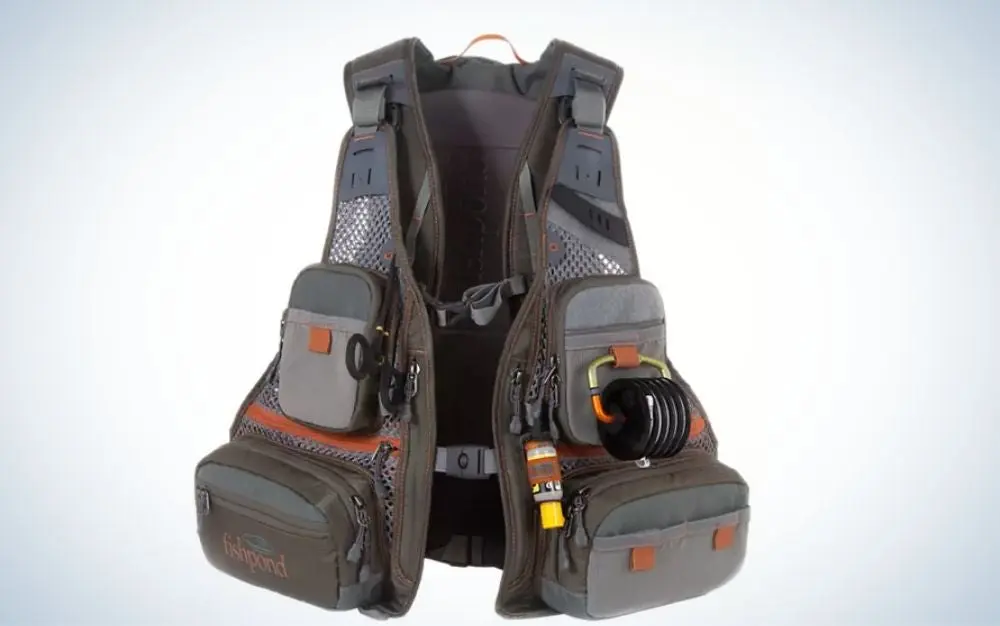
Specs
Weight: 47 oz.
Material: Recycled nylon Cyclepond fabric
Sizing: One size fits all
Pros
The backpack style adds extra storage
Padded straps are great for all-day comfort
Pocket placement keeps gear from moving around on long hikes
Cons
Heavier than traditional vests
Backpacks work great for hauling gear to remote fishing spots, but when it’s time to fish, you’re constantly digging through the pack looking for gear. The pack-and-vest combo has gained popularity for this reason, and the Fishpond Ridgeline Tech Pack is one of the best. The backpack is sized to carry rain gear, water, food, rod tubes, and any other bulky accessories, while the vest carries all of your fishing tackle. On long hikes to a remote spot, this is great to get on the water quickly rather than taking time to reorganize gear. All your flies, tippet, and tools will be in the same spot every time. Unlike traditional vest designs, this pack incorporates backpack-style straps to disperse the weight, even with heavy loads. If you like taking photos of the places you go and the fish you catch, the backpack portion is a fine spot to store a camera. For extra padding, I’ll often wrap my rain gear around the camera to keep it from shifting in the pack.
What to Consider When Choosing a Fly Fishing Vest
Staying organized while fly fishing
can be difficult. If you don’t have the right vest, you’ll soon have flies, leaders, and weights everywhere. Choosing the right vest can help keep your gear organized and ready to go. Here’s what to look for:
Storage
The most important aspect when choosing a vest is the storage and layout of the vest. A well designed vest has the right number of pockets to keep the basics organized, without having so many pockets that you forget where things are. I like a vest with two main storage pockets for fly boxes, and some smaller pockets for leaders, nippers, and other accessories. Anything more will have you digging through pockets to find something you thought you had. For those looking for a little more storage, several backpack and vest combos are available for longer day trips to pack food and drinks. Choose a vest that has enough storage to keep you fishing all day, without weighing so much that it becomes a burden.
Durability
Any fly fishing vest worth wearing must withstand the elements. Trudging through the brush, fishing through the rain, and baking in the sun are the norms when chasing trout. To withstand those conditions, the best fishing vests are made from breathable and durable fabrics such as woven nylon. In addition, most vests will come with a DWR coating to repel water and keep you dry in case of a surprise shower. No matter what vest you choose, make sure it’ll hold up against the elements that are common where you plan to fish.
Comfort
For a fly fishing vest to be comfortable, breathability, airflow, and a minimalist design are key. Breathable fabrics are often used in the vest panels to improve airflow. Other vests utilize mesh in places such as shoulder straps to cut down on weight and allow air to freely flow through the vest. A minimalist design cuts down on the overall fabric, which results in a more breathable vest.
FAQs
Q: How much does a good fly fishing vest cost?
Fly fishing vests vary widely in price range depending on the features and materials used to build them. For beginners or those on a budget, a good vest can be found in the $50 to $100 range. These vests feature ample storage and materials built to withstand some abuse. Those wanting more technical fabrics and well-laid-out vests should be willing to spend $150 to $250 depending on the brand and features. Larger vests including pack vests tend to lean closer to the $250 range, while ultralight and technical vests will be closer to the $150 price point. Regardless of your budget, there are premium vests that will keep you organized at any price point.
Q: What do you put in a fly fishing vest?
Every angler has their preferences when it’s time to organize their fly fishing vest. It depends a lot on how you fish and the species you target. As a trout angler, some of the important items to include are flies, leaders, tippets, and tools. For flies, I typically carry a couple of low-profile boxes for nymphs, a small streamer box, and a dry fly box with higher sides to not squish the hackles. This gives you plenty of options to change it up throughout the day depending on conditions.
As for tools, I pack a nipper to cut line, forceps to unhook fish, fly floatant, and an amadou patch for drying dry flies. Nymph fisherman should also carry weights and indicators to effectively detect strikes. Lastly, I pack a variety of leaders and tippets ranging from 6X to 2X.
Q: What is the pocket on the back of a fishing vest for?
The pocket on the back of a vest is meant to be an all-around storage pocket. I’ve used the pocket for a variety of things, including packing a lunch, storing rain gear, and even holding a camera in a pinch. Whatever you decide to put in that pocket, make sure it’s something you won’t use frequently, because getting to it—especially if you’re standing in the middle of the river—can be tough.
Q: Are all fishing vests waterproof?
No fly fishing vest is truly waterproof. However, with modern materials and specialized coatings, several vests are highly water-resistant. If a brief summer shower hits or a fish decides to splash you, these vests will bead the water off. But when it’s pouring all day, no vest will stay dry. That being said, with a good rain jacket under the vest you can still fish with all your gear like you typically would. Just remember to dry everything out when you get back so your flies won’t rust.
Best Fly Fishing Vests: Final Thoughts
Best Traditional: Simms Guide Vest
Best for Trout: Fishpond Sagebrush Pro Mesh Vest
Best Lightweight: Orvis Ultralight Vest
Best for Beginners: Redington Blackfoot Vest
Most Versatile: Fishpond Ridgeline Tech Pack
Fly fishing vests have been around since the beginning of the sport for a reason: they work. Staying organized so you can keep your fly in the water as much as possible is crucial to catching more fish. The right vest keeps everything you need easily accessible and can make rerigging quick and efficient. To get the most out of your vest, look for one that fits, has plenty of storage, and is comfortable enough to wear all day. Finding a vest that meets all three qualifications is the best way to guarantee you’ll get the most out of it.
Why Trust Us
For more than 125 years, Field & Stream has been providing readers with honest and authentic coverage of outdoor gear. Our writers and editors eat, sleep, and breathe the outdoors, and that passion comes through in our product reviews. You can count on F&S to keep you up to date on the best new gear. And when we write about a product—whether it’s a bass lure or a backpack—we cover the good and the bad, so you know exactly what to expect before you decide to make a purchase.
![Field & Stream [dev]](https://images.ctfassets.net/fbkgl98xrr9f/1GnddAVcyeew2hQvUmrFpw/e4ca91baa53a1ecd66f76b1ef472932b/mob-logo.svg)





